In the six-plus decades since its original release, the general reception and critical reputation of Ingmar Bergman’s The Seventh Seal has ebbed and flowed like beating waves crashing against a rocky Swedish shore. Though initially lambasted at home, the film won the Special Jury Prize at Cannes. Later, Janus Films’ savvy marketing positioned Bergman at the center of the international art-house phenomenon, and Bergman-the-auteur became the brand of a global movement. When Bergman’s art turned inward and the New Wave spread across several continents, The Seventh Seal became less interesting to a generation of psychoanalytic and feminist critics. Nonetheless, it remained a staple of film-school curricula, a source of inspiration for a generation of filmmakers, and a rich source of parody for hundreds of clever wags keen to lampoon its iconic imagery.
For a film that has long represented Bergman’s art—and arthouse cinema more broadly—The Seventh Seal stands as something of an anomaly alongside much of the director’s other work. For one thing, it’s way funnier even than most of his comedies, especially for a film that is largely marked by Death. It is gentler, too, further-reaching and more profound. It’s also a bit of a shape-shifter, with its elusive meanings evolving and mutating over the decades. Rewatching during our current coronavirus pandemic lends fresh new meanings to this especially evergreen film, as The Seventh Seal asks viewers to contemplate our faith, doubt, humility, and empathy in newly troubling times.
Bergman developed The Seventh Seal from medieval art into a theatrical play, first performed for radio broadcast and only later reconceived for the cinema. Its plot is exceptionally simple: a weary, disillusioned knight, Antonius Block (Max von Sydow) and his earthy squire Jöns (Gunnar Björnstrand) return from their decade-long Holy War crusade to their native Sweden, where evidence of the plague is omnipresent. Confronted on the shore by the literal personification of Death himself (Bengt Ekerot), the Knight famously challenges him to a game of chess, hoping to buy time: for as long as the game continues, Antonius will remain alive and able to seek proof of God’s existence.

As the Knight and Squire travel, they encounter a sweet young family—the vision-prone juggler Jof (Nils Poppe), his wife Mia (Bibi Andersson), and their infant son Mikael. Others they meet include their vainglorious actor friend, a dullard blacksmith, his vixenish wife, a seminarist-turned-thief, a mute, an unnamed servant girl, and an imprisoned woman suspected of witchcraft. The Knight’s desperation to affirm proof of God’s existence coincides with his increasingly desperate position on the chessboard; when Death’s victory seems certain, the Knight attempts a rash act that he hopes will buy his friends escape. As Death claims Antonius and his friends, the young family is spared.
To describe the plot is to do The Seventh Seal a mild injustice, of course. Its setting may be bleak and desolate, but the film is full of charm and wit. Death’s portrayal as a black-garbed, chalk-faced grim reaper may have its root in ancient legend, but Bergman and the actor Bengt Ekerot imbue the character with a morbid, trenchant wit. Death harbors no ill will and takes to his busy work with relish, whether parrying the Knight’s maneuvers or cutting down the actor Skat with a spate of well-placed verbal jabs. When crossed, he rises to challenge with a steely glare. Von Sydow’s Antonius Block may be wracked with doubt, but his questions are earnest. His squire Jöns gets off a number of good lines—and can be trusted in a dustup to take action, in contrast to the near-paralysis Antonius’ crisis of faith seems to engender in him.
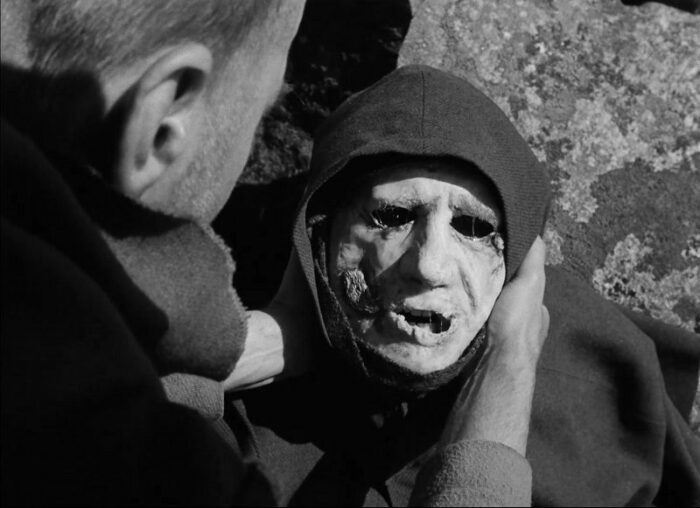
The film’s gentle grace and good humor are shot with incredible dexterity by cinematographer Gunnar Fischer. Its imagery and compositions are remarkable, especially given the film’s small budget and modest shooting schedule: all but two scenes were shot at Råsunda Film Studios. Images of the cloudy sky, rocky beach, chessboard at sunrise, or even a playful squirrel leaping atop a fallen tree stump—nearly every frame of the film feels rich and brilliant in its cinematography even today, and especially in its most recent remastering.
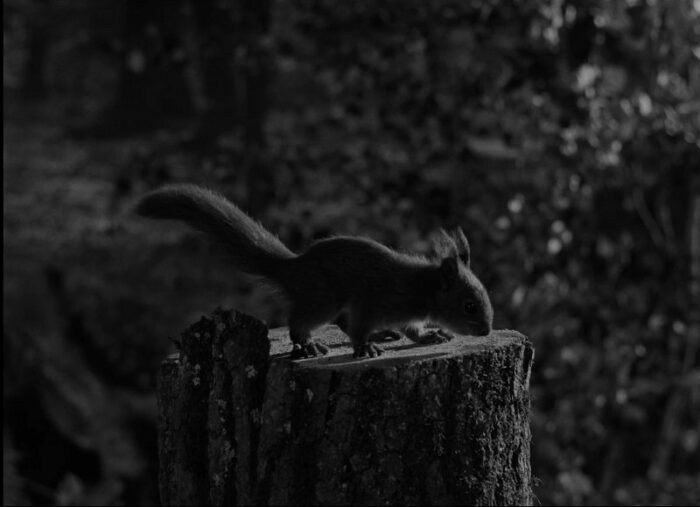
Of course, The Seventh Seal has always been among Bergman’s most sprightly, humorous narratives and the most handsomely shot. Were it for those qualities alone, the film might be known only as a quaint medieval period piece, an experimental one-off for a director known first for the series of thrillers, comedies, and romances he directed beforehand. The Seventh Seal, though, was able to pose some of the most abstract—and compelling—questions of any cinema. Its timing was canny. A decade after the end of World War II, brought about in part by the use of atomic weaponry that had the power to lay waste to civilization, The Seventh Seal asked its viewers how to cope with a world that could end, and end hard. Would they respond with faith? Doubt? Grace? Treachery? Blame? Fear?
Not unlike how genre films of the decade—films as diverse as Godzilla, Night of the Hunter, The End of the Affair, and Kiss Me Deadly—read as ruminations on the very real effects of atomic devastation, The Seventh Seal too took on its meaning as a consequence of the very real concerns its contemporary viewers faced in the wake of the Cold War arms race of the 1960s and its apocalyptic promise of mutually assured destruction. For the hundreds of thousands of viewers of that decade who entered the cinema wondering how their world would end, Bergman’s film showed them a set of circumstances that, despite their occurring some six centuries earlier, informed their contemporary condition.
The film’s depiction of the Black Death, the plague that ravaged much of Eurasia and Africa, offered less a rigorously historical study of a pandemic than an occasion for ruminating on the ways a contemporary world might end. In an era of always-escalating nuclear armament, the fear of a third World War, perhaps one brought about by religious persecution or international hostilities, could not help but inform viewers of The Seventh Seal. Some years later, the scourge of AIDS would escalate to take the lives of hundreds of thousands, and that epidemic would instill fear in LGBTQ+ communities and provoke fearmongering from the religious right. Then too, the church largely held that that plague was sent by God to punish those it condemned as sinners. With each nuclear threat or viral outbreak, The Seventh Seal took on new meanings.
I’ve rewatched The Seventh Seal countless times Over the past few decades, and never has it seemed so relevant as it does today. The world has battled the coronavirus pandemic for more than a year, and as in Bergman’s tale, death again is taking its toll. As of this moment COVID-19 has caused over four million deaths and counting, with the Delta variant spiking case numbers, vaccination rates stalling, and public-health mandates challenged, rebuked, and ignored. In The Seventh Seal, Bergman’s characters travel with trepidation, their grasp of their situation tenuous and partial, relying on lore and suspicion to protect them from what they understand to be God’s will—or, perhaps, his vengeance. Are we, today, that different?
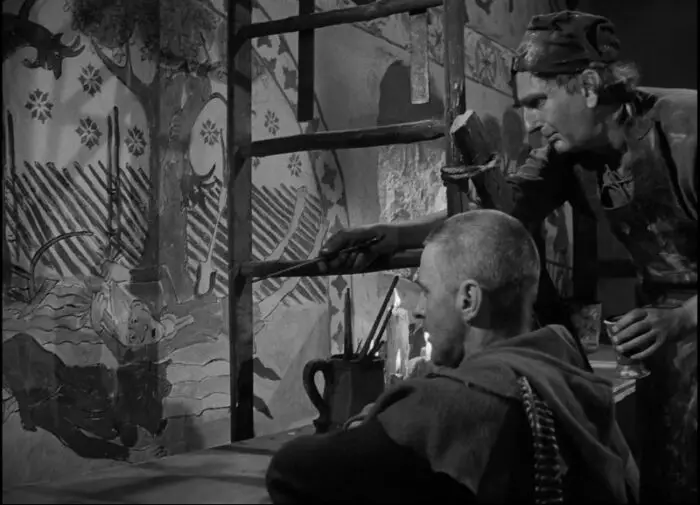
The Black Death was the most fatal pandemic in human history, resulting in between 75 and 200 million deaths, most in Europe in the middle of the 14th century. Still debated today, its means of transmission was unknown at the time, centuries before early public health experts like John Snow taught the importance of simple preventive measures like handwashing. Bergman’s characters fear both its transmission and its symptoms, depicted in part by the church painter recounting victims’ pustulous abscesses, limbs knotting in frenzy, tearing at boils, scratching veins, and agonizing screams.
The Black Death indeed was brutal. Victims suffered acral gangrene, inguinal buboes, severe pain, bloody tumors, and painful vomiting—and death within days. Only thanks to the work of officials to quarantine new port arrivals, a first step in what is today a common practice to avoid contagion, did the plague eventually abate. In Bergman, characters turn to prayer in the absence of science: Block petitions his lord for proof of existence, monks incarcerate and burn suspected witches, and parades of flagellants punish themselves seeking their god’s forgiveness.
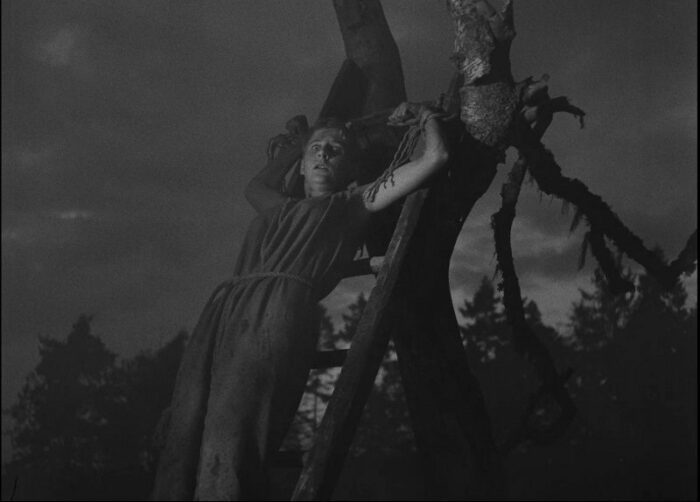
It might be nice to think that in the seven centuries between Bergman’s setting and our own times, humanity has progressed. During the pandemic, every workday, errand, and interaction becomes an exercise in risk management, a virtual chess game of sorts. Some have been able to exercise free will in that decision-making, others compelled to work even in areas and moments of high transmission. Others not only flout simple public health measures but hector those with the temerity to follow them. Unlike many today, Bergman’s Knight at least understands that his actions may have consequences that impact others beyond himself; for all his inward, isolating self-doubt, Antonius Block is nonetheless a man who hopes his life and work have meaning, who comes to learn his own needs may be of less importance than the welfare of others.
While scientists, researchers, and government entities raced to create a set of highly effective vaccines, the hesitancy of a portion of the population has allowed variants to escalate and prevent herd immunity. Politicians and activists have sowed doubt over the efficacy of the simplest of public-health measures, and some pastors have misled their congregations. If in The Seventh Seal any rational viewer can register the futility of burning an accused witch at the stake for her supposed spread of the disease, it’s disheartening to see a contemporary frozen-food heir turned television personality declare to his an audience of over half a million viewers that the U.S. government’s leading public health authority literally “helped create COVID.”
That kind of rhetoric isn’t too far from Bergman’s vile monk spewing hatred at those not in his thrall. While it’s a particularly egregious example, it’s hardly the only instance of those who would abuse their influence, blame others, or even willfully spread the disease by virtue (or lack thereof) of their behaviors.
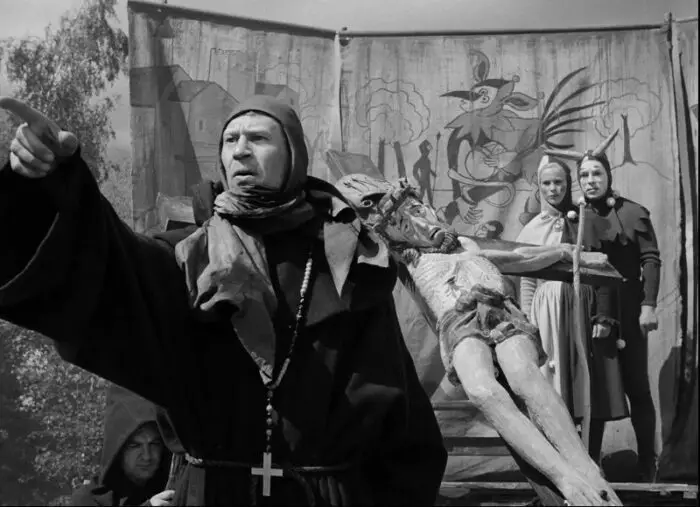
Aside from Bergman’s principal characters—the Knight, his Squire, Jof and his family, and the literal and enigmatic personification of Death who follows them—his humanity is largely a sorry lot. Skat the actor cares only about his gastric and sexual fulfillment. Raval the seminarian led thousands astray in a futile cause and now scavenges others’ wealth. Lisa is quick to abandon her husband for a few moments of pleasure, while her husband Plog is too dull to process her duplicity. Their religious leaders can only threaten and vilify nonbelievers with the scourge of the plague. The nameless flagellants have nothing to offer other than their own misguided penitence before Lennart Wallén’s edit dissolves them into dust. In the 21st century, blessed with the progress of science, has humanity learned to aspire to something higher than simple gratification of urges? To resist the rhetoric of those twisting the truth for their own gain? To serve their faith without the condemnation and vilification of others?

It’s remarkable that in his 14th-century setting, Bergman creates what to me is ultimately a largely affirmative film. After the failure of his primary strategy—a combination of the bishop and knight, as if his long and failed experience in the Crusades had not yet illustrated the folly of marrying religion and military—Block’s is a desperate gambit to reset the chessboard. That ploy may not alter the course of his game with Death, but it’s just possible that doing so buys Jof and Mia the time they need to escape. The act may not be the tangible proof of God’s existence he originally sought, but in the family’s simple communion The Knight observed a love and faith worth preserving. Even in a film where death (Death) is everywhere and omnipresent, where the lot of humanity may not seem worth fighting for, life is still worth living and faith worth seeking.
Mine is admittedly a charitable interpretation of the events of The Seventh Seal. It’s by no means universally held. Bergman’s setting is a bleak one—its plague unyielding, Death relentless, and even the most virtuous of characters powerless. But then, I confess I’ve always been charmed by its gentle humor, breathtaking cinematography, and engaging performances. At least twice a year for over three decades, I’ve found in The Seventh Seal not just the apotheosis of foreign arthouse cinema the film seemed in cultural circles to ossify as, but instead a perpetually surprising, intellectually confounding, and morally uplifting film unlike any other I’ve ever seen.
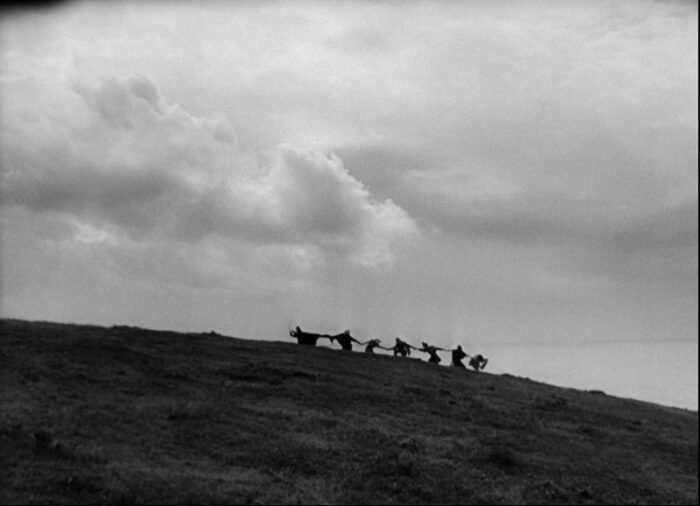
That characterization includes the majority of Bergman’s other work, especially those that preceded The Seventh Seal. While his films often featured the same crew and many of the same cast, with Björnstrand in particular the pillar of his stock company, nothing in the director’s earlier oeuvre matched the ambition, scope, reach, or wit of The Seventh Seal. Some historians pounced on its historical infidelities, as witch-burnings and processions of flagellants were nearly nonexistent in the 14th century he depicts, but for that matter, we don’t know either that a black-garbed, bald-pated, chalk-faced, trash-talking Death roamed the countryside taunting plague victims or flexing his chess game, either. The Seventh Seal was not intended to be literal.
Instead, its meanings work still best allegorically. At one time the most pressing interpretation was the conflict between existentiality and Christianity in a time of potential nuclear Armageddon. Decades later, the AIDS epidemic that would claim over 36 million lives brought the film into sharp relief for a new generation of viewers. Today, it may be impossible to watch The Seventh Seal without consideration of the coronavirus pandemic and humanity’s scattershot, ineffective response to its demands. I may not myself have the wherewithal to redirect our response to the current pandemic, but when Death is all around, I can turn to The Seventh Seal again and again for a starkly prescient and deeply resonant treatise on the meaning of life.





Two questions remain with me after finally seeing “The Seventh Seal” recently and here’s hoping that Mr. Johnson can give a view:
1. Why in the penultimate scene is nearly all the company so respectful, with the knight greeting death (“Good morning, noble lord”) and his wife telling death “I …welcome you courteously to my house.” Why would she welcome death? Only Jons resists, with an attitude akin to that of, say, Sartre. What are we to make of that respect and courtesy?
2. Jons’s attitude toward Tyan, the 14-year-old witch, is problematic. His repulsive excuse for failing to save her is that she is “half dead anyway”. A few moments later, he says: “That poor little child. I can’t stand it.” He could have acted. He acts in other situations in the film. Why not here?
David, thank you so for reading Film Obsessive and taking the time to comment. We appreciate our readers’ perspectives and questions! I can’t lay claim to any definitive answers, either here or in the essay itself, and this film has always defied any fixed interpretation, but I’ll do my best:
1. These differing receptions to Death are fascinating. The Knight bows in fervent prayer, the Squire mutters a deflated protest. Others bow to their inevitable fate, and the Knight’s wife courteously welcomes him–his presence not entirely unexpected–to their home. I don’t know that she looks forward to the end of her and her husband’s life but that she will treat any visitor to her home with respect and courtesy. She’s neither as maddeningly devout as her husband nor as grudgingly realistic as his Squire.
2. Antonius is interested in Tyan not for her own plight but because she might, if she has seen the devil, also know his God. He doesn’t act to save the girl either, for what it’s worth, other than to pray for her and offer some small physical comfort. Jöns, meanwhile, is no hero. He does take action to save others (Jof and the unnamed girl in particular), but he is a pragmatist: surely he recognizes here that the believers need their scapegoats. (And saving her here, if he could, would mean taking on a group of trained men rather than a few drunkards at the inn or a weak-kneed seminarian). I take from this scene that neither he nor Antonius feels direct action would do any good in the face of the plague ravaging the countryside. I’m not defending the Squire’s (lack of) action, but it doesn’t seem especially out of character to me.
Well done and a good call-back for a Golden Oldie of the late 1950s early 1960s international film renaissance.